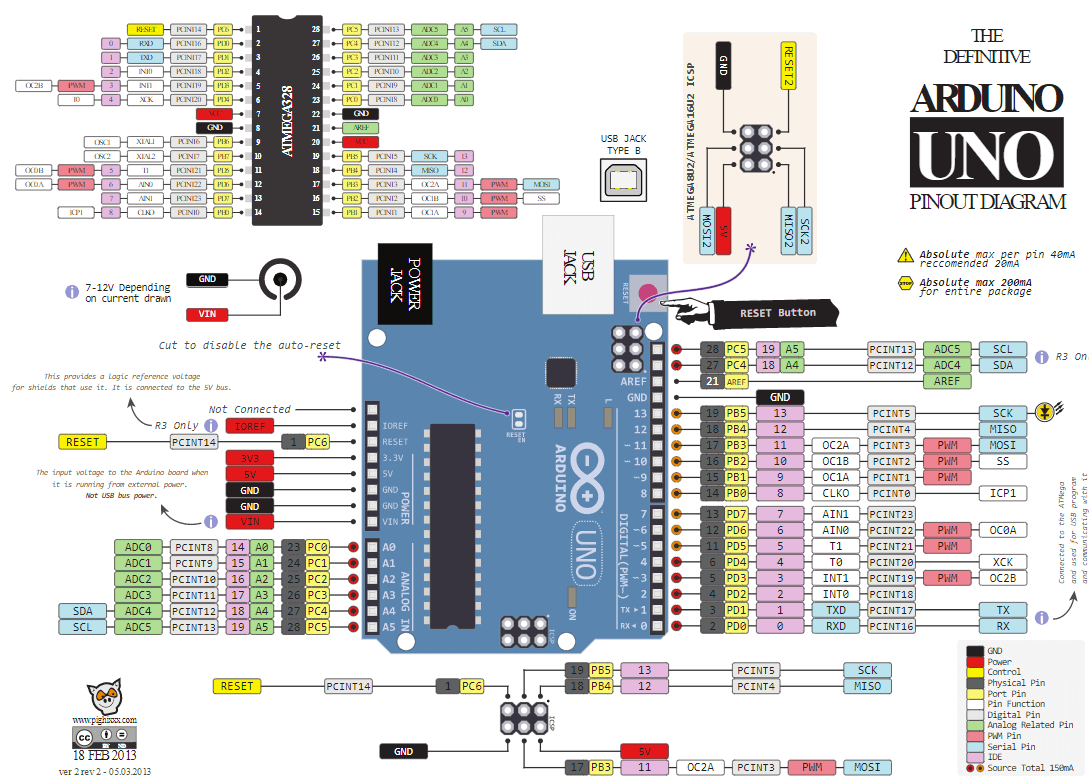Arduino Hard Way
Introduction
The goal of this post is to know how to hard codded the pinout of Arduino. So instead of using the digitalWrite functions and so on, we are going to use bit manipulation.
Why do that?
- Because is cool.
- Over that, because is cool.
- And over that, because is faster, and we may used it in some occasion with limit resources. Besides, all the microcontrollers works using this way if the libraries are not enough developed.
First steps
First, there is good pinout diagram from circuito.io blog

Hello World (Blink!)
Following the pinout and this reference, we could be able to do something.
Basically, To set a pin (put a 1), use the OR operator. To clear a pin (put a 0), use the AND operator. Use together with the ~ operator if using positive logic. To toogle a pin (if 0, set to 1, if 1, clear to 0), use XOR operator.
void setup()
{
// pinMode(13, OUTPUT);
DDRB = DDRB | B00100000; //Set as output bit PB5 (13 in Arduino Uno), other untouched
}
void loop()
{
// digitalWrite(13, HIGH);
PORTB = PORTB | B00100000; // Set HIGH PB5, other untouched
delay(500);
// digitalWrite(13, LOW);
PORTB = PORTB & B11011111; // clear out bit PB5, leave others untouched (xx & 11 == xx)
delay(500);
}
Another way to set and clear the bits is using the shift register. If we want change the bit 5th, the following expression are equivalent:
B00100000 --> (unsigned char)(1<<5)
On the other hand, to clear the bit, we could use always the positive logic, therefore, the mask to set and clear the bit will be the same if we use the Bitwise not operator
PORTB = PORTB & B11011111; --> PORTB = PORTB &~ B00100000; --> PORTB = PORTB &~ (unsigned char)(1<<5);
Applying all together:
#include <Arduino.h>
void setup()
{
// Set bit
// pinMode(13, OUTPUT);
DDRB = DDRB | (unsigned char)(1<<5); //Set as output bit PB5 (13 in Arduino Uno), other untouched
}
void loop()
{
// Set bit
// digitalWrite(13, HIGH);
PORTB = PORTB | (unsigned char)(1<<5); // Set HIGH PB5, other untouched
delay(500);
// Clear bit
// digitalWrite(13, LOW);
PORTB = PORTB &~ (unsigned char)(1<<5); // clear out bit PB5, leave others untouched (xx & 11 == xx)
delay(500);
}
We could even toggle the pin, instead of set and the clear the pin, with the bitwise XOR operation
PORTB = PORTB ^ (unsigned char)(1<<5); // Toggle PB5, other untouched